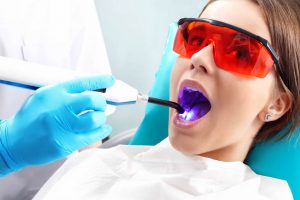Laser Dentistry
Call Us Today
No Cost Consultations
or
$10 Emergency Exam & X-Rays
Laser
 Laser gum treatment is great. The FDA deemed laser dentistry to be safe for public usage in 1990. Since then, many dentists have incorporated dental lasers into everyday procedures – reducing bleeding, anxiety and post-treatment recovery times. The beauty of dental lasers is that they damage far less of the surrounding tissue than traditional techniques – which means less discomfort and pain.
Laser gum treatment is great. The FDA deemed laser dentistry to be safe for public usage in 1990. Since then, many dentists have incorporated dental lasers into everyday procedures – reducing bleeding, anxiety and post-treatment recovery times. The beauty of dental lasers is that they damage far less of the surrounding tissue than traditional techniques – which means less discomfort and pain.
Here are some of the other benefits associated with laser dentistry:
- Faster healing and tissue regeneration.
- Preservation of more of the natural tooth.
- Reduced bleeding during and after treatment.
- Reduced need for anesthesia.
- Reduced need for stitches and sutures.
- Reduced risk of bacterial infections after procedures.
How can laser dentistry help me?
Laser dentistry is incredibly versatile and plays an important role in a growing number of common dental procedures. Though laser dentistry is most notably associated with cosmetic treatments, it is equally effective for preventative purposes.
Here are some of the ways that dental lasers can be used:
- Implant recovery and salvage – The use of the PerioLase laser around an implant site can enhance the healing of the sight. Additionally, an old implant that has periodontal problems or is showing bone loss can be treated with the PerioLase. This treatment can prolong the life of the implant.
- Sterilization and disinfection of periodontal pockets and abcesses – Treatment with the PerioLase will eliminate the bacteria that is imbedded in the periodontal pockets.
- Reshaping soft tissue – Dental lasers can dissolve soft tissue to expose more of the natural tooth (crown lengthening), reshape soft tissue to make “gummy smiles” more attractive, and remove uncomfortable soft tissue folds caused by denture wear.
- Frenectomy – Lasers can improve speech and the feeding habits of babies, children and adults by untying the tongue.
- Tumor removal – When benign tumors have formed in the soft tissue areas of the mouth, a dental laser can completely remove them without causing pain.
- Whitening – Lasers can greatly expedite the tooth whitening process by increasing the activity of the particles in the peroxide bleaching solution.
- Biopsy – Lasers are sometimes used to perform a biopsy on suspicious areas of soft tissue. This biopsy procedure can be performed instantly and with great precision.
How are laser procedures performed?
Different types of dental laser have been created to treat different conditions. Each laser uses a different wavelength of light, which predicates its best use. The most common types of dental laser are carbon dioxide lasers and diode lasers, which are usually employed to treat soft tissue problems.
The laser beam is extremely bright, and special glasses will be provided to protect the eyes. The dentist will then direct the beam at the affected area and carefully dissolve the soft tissue, harden the filling or whiten the teeth.
The procedure will take far less time than conventional methods, and cause far less anxiety and discomfort. The only real disadvantage of laser dentistry is that it can prove to be more expensive.
Dr. Rodeghero is trained and licensed in the patented protocol of the only laser approved by the FDA. He uses the PerioLase made by Millennium Dental Technologies, Inc. The results from this laser surgery have shown consistently positive probing depths and clinical attachment level changes, as well as proof of new attachment and periodontal regeneration in patients.
These results are achieved by using the Laser Assisted New Attachment procedure (LANAP). This procedure eliminates the pain and discomfort associated with most perio surgery, as there are no scalpels or sutures required.
If you have questions or concerns about laser dentistry, please contact us.